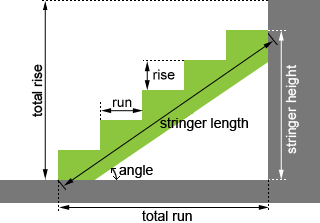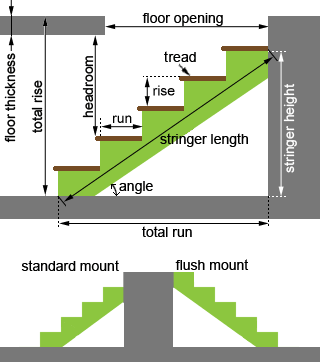Stair Calculator
The Stair Calculator is an online tool for calculating various parameters involved in the construction of stairs. Refer to the figure adjacent to the calculator as a reference. A fraction to decimal conversion table for common fractions used in measurements is also provided at the bottom of the page.
Basic Version
Result
| If 10 Runs (Steps) | |
| # of Rise | 11 |
| # of Run | 10 |
| Rise | 9.64 inches or 24.48 cm |
| Total Run | 8 feet 4 inches or 254.00 cm |
| Stringer Length | 11 feet 6.87 inches or 352.74 cm |
| Stringer Height | 8 feet 0.36 inch or 244.76 cm |
| Angle | 43.94° |
| If 11 Runs (Steps) | |
| # of Rise | 12 |
| # of Run | 11 |
| Rise | 8.83 inches or 22.44 cm |
| Total Run | 9 feet 2 inches or 279.40 cm |
| Stringer Length | 12 feet 2.77 inches or 372.80 cm |
| Stringer Height | 8 feet 1.17 inches or 246.80 cm |
| Angle | 41.46° |
| If 12 Runs (Steps) | |
| # of Rise | 13 |
| # of Run | 12 |
| Rise | 8.15 inches or 20.71 cm |
| Total Run | 10 feet or 304.80 cm |
| Stringer Length | 12 feet 10.83 inches or 393.28 cm |
| Stringer Height | 8 feet 1.85 inches or 248.53 cm |
| Angle | 39.19° |
| If 13 Runs (Steps) | |
| # of Rise | 14 |
| # of Run | 13 |
| Rise | 7.57 inches or 19.23 cm |
| Total Run | 10 feet 10 inches or 330.20 cm |
| Stringer Length | 13 feet 7.06 inches or 414.17 cm |
| Stringer Height | 8 feet 2.43 inches or 250.01 cm |
| Angle | 37.13° |
| If 14 Runs (Steps) | |
| # of Rise | 15 |
| # of Run | 14 |
| Rise | 7.07 inches or 17.95 cm |
| Total Run | 11 feet 8 inches or 355.60 cm |
| Stringer Length | 14 feet 3.43 inches or 435.43 cm |
| Stringer Height | 8 feet 2.93 inches or 251.29 cm |
| Angle | 35.25° |
| If 15 Runs (Steps) | |
| # of Rise | 16 |
| # of Run | 15 |
| Rise | 6.63 inches or 16.83 cm |
| Total Run | 12 feet 6 inches or 381.00 cm |
| Stringer Length | 14 feet 11.93 inches or 457.03 cm |
| Stringer Height | 8 feet 3.38 inches or 252.41 cm |
| Angle | 33.52° |
| If 16 Runs (Steps) | |
| # of Rise | 17 |
| # of Run | 16 |
| Rise | 6.24 inches or 15.84 cm |
| Total Run | 13 feet 4 inches or 406.40 cm |
| Stringer Length | 15 feet 8.56 inches or 478.93 cm |
| Stringer Height | 8 feet 3.76 inches or 253.40 cm |
| Angle | 31.94° |
| If 17 Runs (Steps) | |
| # of Rise | 18 |
| # of Run | 17 |
| Rise | 5.89 inches or 14.96 cm |
| Total Run | 14 feet 2 inches or 431.80 cm |
| Stringer Length | 16 feet 5.29 inches or 501.11 cm |
| Stringer Height | 8 feet 4.11 inches or 254.28 cm |
| Angle | 30.49° |
| If 18 Runs (Steps) | |
| # of Rise | 19 |
| # of Run | 18 |
| Rise | 5.58 inches or 14.17 cm |
| Total Run | 15 feet or 457.20 cm |
| Stringer Length | 17 feet 2.12 inches or 523.54 cm |
| Stringer Height | 8 feet 4.42 inches or 255.07 cm |
| Angle | 29.16° |
| If 19 Runs (Steps) | |
| # of Rise | 20 |
| # of Run | 19 |
| Rise | 5.3 inches or 13.46 cm |
| Total Run | 15 feet 10 inches or 482.60 cm |
| Stringer Length | 17 feet 11.04 inches or 546.19 cm |
| Stringer Height | 8 feet 4.7 inches or 255.78 cm |
| Angle | 27.92° |
| If 20 Runs (Steps) | |
| # of Rise | 21 |
| # of Run | 20 |
| Rise | 5.05 inches or 12.82 cm |
| Total Run | 16 feet 8 inches or 508.00 cm |
| Stringer Length | 18 feet 8.03 inches or 569.05 cm |
| Stringer Height | 8 feet 4.95 inches or 256.42 cm |
| Angle | 26.78° |

Comprehensive Version

Stair terminology and common building codes
Stairs come in many different forms, and while building a basic staircase may appear to be a simple task, there are actually a number of parameters, calculations, and building codes that must be considered. These range from the length, width, and height of specific parts of the stairs, to where doors are placed in relation to stairs; the arc of a door must be completely on the landing or floor and not be allowed to swing over steps. Below is a list of some of the most common terminology regarding stairs, as well as some commonly used building codes. Building codes or requirements can differ at a local level, and a person building a staircase should refer to the codes specific to their locations.
Run/Tread: The run or tread is the part of the stairway that a person steps on. Its length is measured from the outer edge of the step, which includes the nosing if it is present, to the vertical portion of the stair called the riser. Both nosing and riser are discussed below. When measuring the total run of a staircase, the length of the tread above the last riser is not included in the measurement. Also, when nosing is present, the total run is not simply the sum of tread length, since the overhang caused by the nosing must be subtracted from the total run.
Building codes generally suggest that the thread has a minimum length of 10 inches (25.4 cm).
Rise/Riser: The rise, or height of a step is measured from the top of one tread to the top of the next tread. It is not the physical height of the riser because this excludes the thickness of the tread. The number of risers, not the number of treads, is used to determine the number of steps that comprise a staircase.
Building codes generally suggest that the maximum height of a riser be 7.75 inches (19.7 cm)
Nosing: The nosing is the protrusion at the edge of a tread that hangs over the riser below. Not all steps have a nosing, but when present, the nosing is included in the length of the tread. The main purpose of nosing is to improve safety by providing extra space on which a person can place their feet.
Common building codes generally suggest that the nosing has a minimum length of 0.75 inches (1.9 cm) and a maximum length of 1.25 inches (3.2 cm).
Headroom: Headroom is the height measured from the top of a tread to the ceiling above it. While building codes for headroom are primarily intended to ensure enough room for people to comfortably use the stairs, the codes typically require far more room than the average height of a person to allow for moving larger objects such as furniture.
Building codes generally suggest at least 6 ft. 8 inches (203.2 cm) of stair headroom.
Stair Width: Stair width is measured from edge to edge of each side of the tread, perpendicular to tread length. While measurements of length are conventionally longer than those of width when considering rectangles, in the case of steps, the width is usually the longer side. Stair width does not include handrails.
Building codes generally suggest that stairs be at least 36 inches (91.44 cm) wide.
Handrails & Guards/Guardrails: A handrail is a railing that runs up a stair incline for users to hold when ascending or descending a staircase. A guard is "a building component or a system of building components located near the open sides of elevated walking surfaces that minimizes the possibility of a fall from the walking surface to the lower level." Guards can include rails (guardrails), but can be any number of other constructions such as walls, half-walls, or even a bench.
Building codes generally require guards for stairs that have a total rise of more than 30 inches above the floor, and require that these guards be at least 34 inches (86.36 cm) in height measured from the top of the treads. Similarly, handrails must be between 34 and 38 (96.52) inches high measured from the top of the treads, with a diameter between 1.25 inches (3.18 cm) and 2.675 inches (6.79 cm).
Stringer: A stair stringer is a structural member that supports the treads and risers of a staircase. Typically, there are three in a staircase: one on each side, and one in the middle. Stringers are not always visible, but can be seen on stairs with open sides. The stringers can either be cut to the shape of each step, or in some cases, are uncut and conceal the edges of the treads.
Fraction to Decimal Conversion
| 16th | 8th | 4th | 2nd | Decimal |
| 1/16 | 0.0625 | |||
| 2/16 | 1/8 | 0.125 | ||
| 3/16 | 0.1875 | |||
| 4/16 | 2/8 | 1/4 | 0.25 | |
| 5/16 | 0.3125 | |||
| 6/16 | 3/8 | 0.375 | ||
| 7/16 | 0.4375 | |||
| 8/16 | 4/8 | 2/4 | 1/2 | 0.5 |
| 9/16 | 0.5625 | |||
| 10/16 | 5/8 | 0.625 | ||
| 11/16 | 0.6875 | |||
| 12/16 | 6/8 | 3/4 | 0.75 | |
| 13/16 | 0.8125 | |||
| 14/16 | 7/8 | 0.875 | ||
| 15/16 | 0.9375 | |||
| 16/16 | 8/8 | 4/4 | 2/2 | 1 |